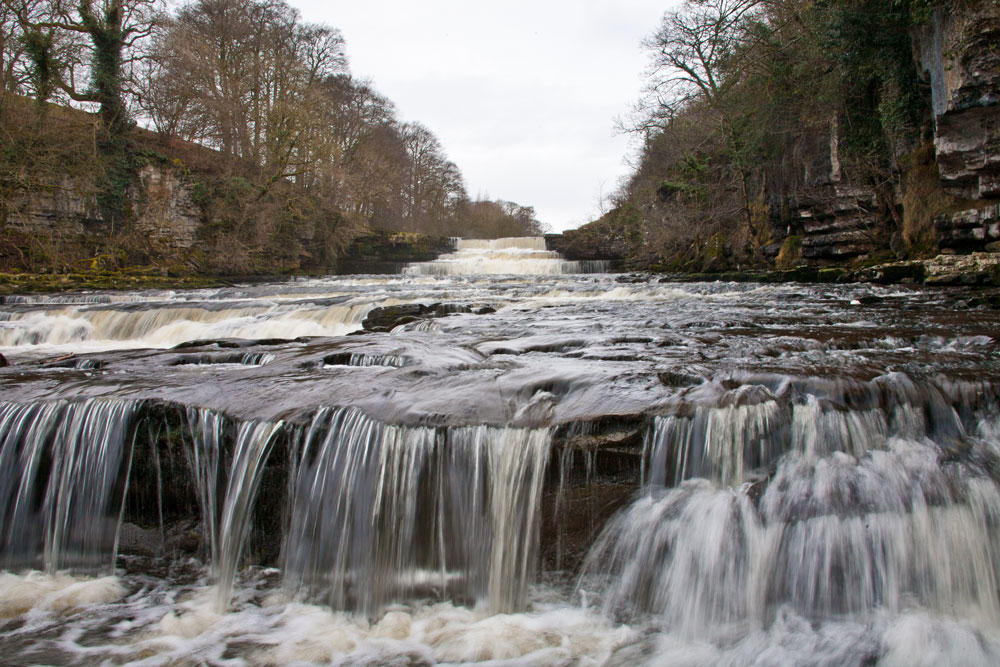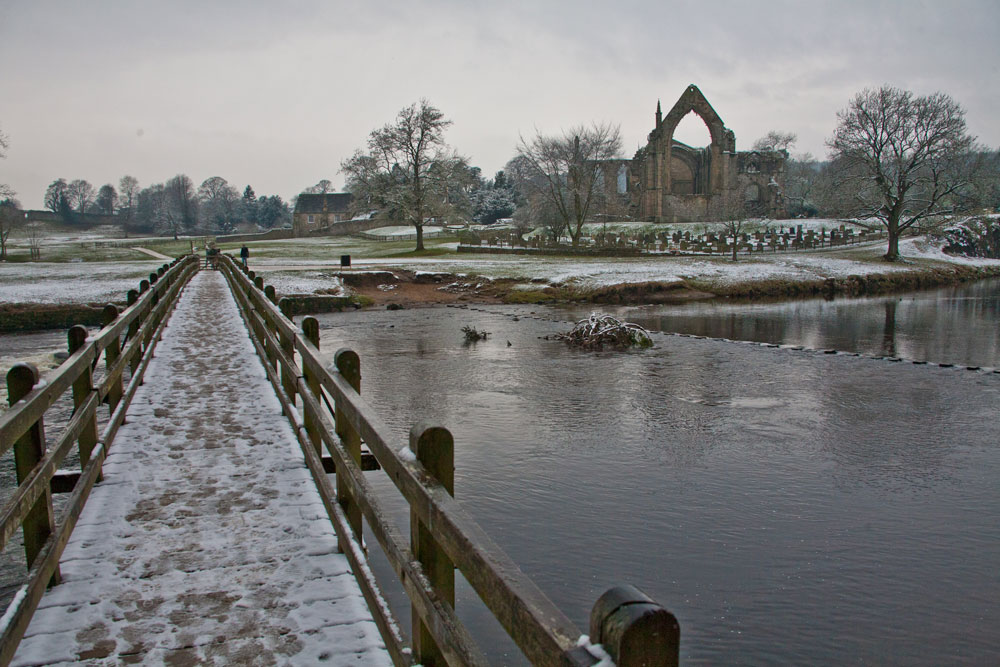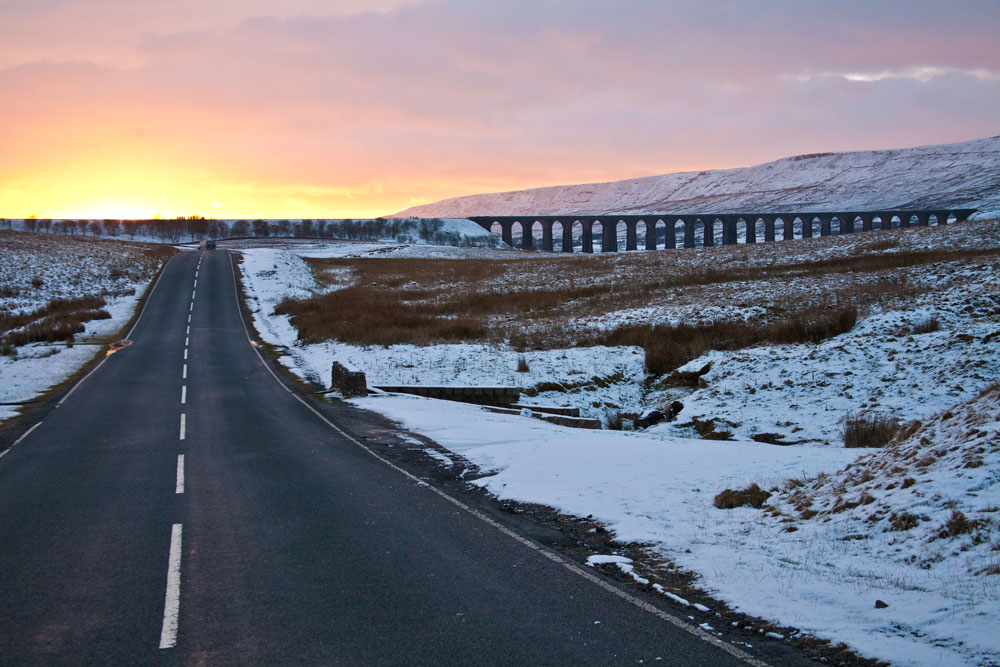Motorhome travel: The Yorkshire Dales National Park
Words and photos by Martin Dorey
We wake in the car park of the Fat Lamb inn at Kirby Stephen. As an overnight to take us from the Lakes to the Dales, it’s perfect: near enough to the M6 and just outside the national park. It had to be perfect, too, simply because we wanted to know where we’d stay as there were few other choices on a winter’s day with dark snow clouds building and plummeting temperatures. Besides, I fancied a pint.
It’s first light when we rise, which isn’t that early but feels it. I dare to peer out of the blinds. There is a sharp frost on the gravel car park and there are light flakes drifting down. We dress for a cold day.
Exploring the Yorkshire Dales National Park
We haven’t really got a route planned for our journey to explore the Yorkshire Dales National Park other than to navigate our way around a few of the dales, avoid snow drifts and try not to get stuck on the little roads that go over the high crags. As we eat breakfast we gaze on the map, looking for a start point that will characterise the countryside we’re about to explore.
The Dales is an area of limestone pavements, crags and coves. Beneath the surface lie cave systems and underground rivers. Above ground there are areas of wild upland, miles of dry stone walls, ancient field systems and stone-built villages.
And then there’s rivers with waterfalls, when rock and water collide in the most spectacular fashion. The two enjoy a special relationship, with one yielding, over many thousands of years, to make spectacular geological features. And hey, everyone loves a waterfall, don’t they? I certainly do. We make up our minds to seek some out.
Famous waterfalls at Hardraw Force and Aysgarth
More snow is forecast, so we set off on the A683 to Sedbergh to pick up the A684 along Garsdale towards Wensleydale and Hardraw Force. It’s a route that would deliver us two great – and quite famous – falls.

Hardraw has England’s longest single drop, of 100 feet and was made famous by Wordsworth, Turner and, of course, latterly, by Kevin Costner. In the geographically challenged film, Robin Hood: Prince of Thieves, Costner’s Robin Hood was caught washing in Hardraw Force by Maid Marion. Must have been summer, but it does mean there’s the possibility of a quick, if cold, dip.
Indeed it must have been summer, because we were unable to gain access, partly due to the season and partly due to a change in ownership. We have no choice but to abandon our plans – for the moment – of looking at cold water and wondering if we have the nerve to swim. Frankly it’s a relief.
We continue towards Aysgarth, a little further down Wensleydale, to the location of another of Costner’s epic scenes and another spectacular set of falls.
As we descend Wensleydale we follow the River Ure along its winding, lazy course. Sandwiched between Bolton Moor to the north and Witton Moor to the south, Aysgarth sits in a gentle squeeze in an otherwise broad dale.
The falls, which have long been admired by artists, painters, poets and Hollywood superstars with an eye for a picture, feature a series of three drops over the course of a mile-long stretch, called, unsurprisingly, Upper, Middle and Lower Falls. We take a left and drop down Church Bank, a steep hill with hairpin bend, which, happily for us, is open, and cross the river, taking another left into the National Park Visitor Centre car park, which is not, so we pull on our outdoor clothes and stroll off to find a good viewpoint.
We cross the road and head into Freeholders Wood, run by the Woodland Trust as a site of special scientific interest. It’s mainly hazel but also contains holly, ash and oak. The path brings us out at a lookout point overlooking the lower falls.
Of course the falls are impressive, but rather than comprising of a single drop they are more like a cascade. The water chatters over flat slabs of limestone into dark pools in a series of little drops. The sound of rushing water dominates.
Not content with the viewpoint, we walk on downstream until we find an access point to the river, a steep bank that brings us out onto the rock bed. I find a slab that protrudes into the water and edge along it carefully so I can take pictures. The light is flat and the sky is grey as I snap away, hoping that the shots will convey some of the drama. We remember Robin Hood’s battle with Friar Tuck on a ledge just like this.
Again, I think, it must have been summer when they filmed it. The water looks very cold; we don’t swim.
Knaresborough and Wharfedale
The snow continues to fall in big, fat, flakes the following day, although it’s one of those days where it turns to slush quickly. Having followed Wensleydale to the east we arrive at the Caravan and Motorhome Club site at Knaresborough, just north of Harrogate.
With a mission to explore Wharfedale – and hopefully some more falls – we set off through Harrogate on the A59, which takes us through the town and, eventually, to Bolton Abbey. I like the look of Harrogate and I am tempted to call off the day in favour of a cup of coffee and a slice of cake somewhere. This decision is made absolute when, while sitting in traffic, we see a sign for the Turkish Baths.
I take a quick turn and guide the unit, almost immediately, into a motorhome-sized parking space. That’s it! We put on our coats, grab our swimming togs and dash out into the snow.
We are in luck, too. We are just in time for a mixed session, which means we can go in straight away. We have no idea what we are letting ourselves in for so we pay and allow ourselves to be ushered from the bright, all-white reception into a corridor of dark wood panelling with a colourful tiled floor.
It’s as if we stepped from the modern world into a Victorian sanatorium. The building is beautiful, with polished brass, deeply waxed wood and original features everywhere. It feels grand and dignified.
I have never been to a Turkish bath before and I have no idea how to bathe in a Turkish style, so try to remain open and willing to go along with anything. The hot room, so I hear, is 70 degrees Celsius, which makes me wonder how I am going to breathe in there. I change into my shorts and wander out into the ‘cool room’; at 35 degrees it is really not that cold at all.
We walk past the plunge pool, which, at 20 degrees, is warmer than the sea – or any of Yorkshire’s waterfalls – by a long way. We make our way into the first of the bath’s hot rooms. It’s a warm 45˚C that is supposed to get you used to the heat.
The tiled ceiling is vaulted and there are Moroccan arches between the rooms, which lead away from me. I look at the mosaic floor. It’s like a crazy paving of white, black, yellow, red and brown pieces, the water making the tiles shine like jewels.
I’m not good with temperatures above 30, but this is OK, I think. I enter the warm room. That one’s set at 55 degrees, which is a nice day in the desert. Surprisingly, it’s not stifling or claustrophobic, although my sweat glands are working overtime. Droplets are running down my back.
After a few minutes I head for the shower room and rinse off with a warm shower. It’s refreshing, and much more my kind of showering than Kevin Costner’s. To think we had considered swimming in a waterfall!
Then it’s off to the hottest room. We place our towels on one of the long wooden benches and sit down. I heat up, knowing that in a few minutes I will be heading for the tepid – but no doubt refreshing – waters of the plunge pool.
Compared with 75 degrees, 20 is very cold indeed. I’m not usually one of those dippers who take ages to inch into cold water but I can’t hurry this immersion. Liz half dives and half pushes off into a quick breast stroke. I follow, keeping my head above water and pushing out breaths like someone in labour, to stop me from ingesting gulps of pool water.
I think, when I shower off afterwards, in a beautifully warm, blue tiled shower room, that this is an infinitely better experience than dashing across a snowy campsite to stand under a dribble of warm-ish water in a cubicle in a toilet block. And it’s way better than stripping off in the snow to dip in a waterfall. What were we thinking?
Bolton Abbey
Afterwards we head out into the snow again for Wharfedale and Bolton Abbey, a ruined priory on the banks of the Wharfe. We wander around and cross the river on a set of almost submerged stepping stones. It’s a wild contrast to the heat of the Turkish Baths but it’s not unpleasant.

We feel warmed to the core and ready to explore more of these beautiful dales. As we make our way up Wharfedale and into Littondale, the sun comes out and the snow melts quickly in the valley bottoms, but sticks around on the steep sides with their limestone caps overlooking us.
We walk to a crag where there are huge icicles dripping from rock overhangs like mini frozen waterfalls. As the sun warms the air they begin drop off around us, crashing to the ground in shattering cascades of ice.
I realise we’ve been far from discovering all of the Dales’ waterfalls. There are more than we could see in a couple of days, but we're happy. We’ve seen water in all its forms over the last couple of days – from crashing falls to steam rooms, icicles to sleet and snow – and it’s been both invigorating and refreshing. And the best thing? There’s always more to see.

Things you should know when in the Yorkshire Dales National Park
At Bolton Abbey there is a narrow arch, which is 10ft 9in (3.27m) high and only just wider than our motorhome plus mirrors, so beware! You can take an alternative road if your motorhome is on the wider side
Dales Bike Centre in Swaledale is a fantastic place for a coffee. It provides a wealth of information on local rides, as well as route maps and kit
dalesbikecentre.co.uk
In winter there can often be snow on the tops, so check but we found most roads remained open
Salts Mill is a fantastic place to see art, enjoy a coffee, do some shopping or marvel at the magnificent buildings
saltsmill.org.uk
Things you should do in the Yorkshire Dales National Park
Bolton Abbey
At the foot of Wharfedale, this is a gloriously ruined priory on the banks of the River Wharfe, complete with stepping stones, meadows, tearoom and even a pop-up beach come summer time. boltonabbey.com
Harrogate Turkish Baths
One of the finest anywhere and still offering excellent service over 120 years since first opening. Beautifully restored and perfect in every way. turkishbathsharrogate.co.uk
The Falcon Inn, Arncliffe, Littondale
A traditional, unchanged pub that was used as the exterior location for The Woolpack Inn for the Emmerdale series. Order your beer and snacks at the hatch and find a seat among the locals in the tiny snug thefalconinnskipton.co.uk
Salts Mill, Saltaire
This former textile mill near Shipley is actually just outside the Yorkshire Dales National Park, but let's ignore that little fact as it is well worth a visit. You’ll find a fantastic book shop, art exhibitions, including one featuring David Hockney's work, cafés, shops and events in this glorious UNESCO listed building. saltsmill.org.uk
Ribblehead Viaduct
Some 20 miles west of Wharfedale and reached via Settle on the B6479 or from Ingleton on the B6255, this impressive 400m-long, 32m-high, 150-year-old brick-built viaduct is worth a look, if only for the sunsets. It’s now a Grade II listed structure and is remarkably beautiful. It cost hundreds of men their lives to build.
WATCH THE VIDEO








Recent Updates
Engine management lights: all you need to know
What is the engine management light? What does it mean, and what do I have to do? ...
Motorhome air suspension: all you need to know
Motorhomes are heavy and the additional weight of equipment and height of the bodywork can increase the loads ...
Motorhome WiFi: how to get better motorhome internet
Staying connected on the move is more and more essential, so relying on campsite WiFi isn't an option – here ...
A class of their own - our guide to A-class motorhomes
Thinking of trading up to an A-class, or even going straight to the top of the motorhome tree? We guide you ...
Explore overseas on a motorhome dream tour
Enjoy exotic travel in a campervan or motorhome by hiring, swapping with someone else or exporting your ...
Motorhome water systems: everything you need to know
On-board water is an important part of every motorhome – here’s everything you need to know ...
Campervanning in Europe: what you need to know
Whether you're planning a leisurely drive through the French countryside, navigating bustling city streets in ...
Campervan security: all you need to know
With thefts on the increase, it’s important to know how to keep your campervan secure and prevent campervan ...
Campervan furniture: everything you need to know
Our campervan experts guide you through all the essentials for your campervan, including tables, chairs, ...
Campervan finance: how to fund your purchase
Here we look at the different types of campervan finance available, to help you decide what’s the best option ...
Other Articles
Britain’s best used motorhomes
Want a great motorhome without paying the premium for a new one? Here's a guide to the best you can get in the pre-owned market for each layout, ...
Which motorhome? Choosing the perfect motorhome for you
Choosing a motorhome or campervan is one of the biggest buying decisions you’ll ever make, so it's important ...
Campervan washroom essentials: stay fresh on the road
Our guide will take you through the campervan washroom essentials you'll need so you're well-prepared for ...
Dogs in campervans: all you need to know
Follow our advice and your dog will enjoy campervanning as much as you do ...
Electric campervans: all you need to know
Our guide will take you through everything you need to know about electric campervans and what the future ...
Motorhome electrics: a complete guide to your motorhome electrical set-up
Motorhome electrics can dramatically enhance the convenience and comfort of your vehicle – but they can be ...
Lighting for campervans: all you need to know
We guide you through all the lighting options available for you and your campervan, including interior ...
Electric bikes for motorhomes: our ultimate guide
Read our comprehensive guide to electric bikes for motorhome owners, helping you add electric power to your ...
Our guide to 'cheap' motorhomes in 2024
If you're on the hunt for an affordable new motorhome, this is the best place to start – we've rounded up a ...
Campervans in winter: all you need to know
Here's your guide to preparing your campervan for the colder months, whether you will be using it or putting ...